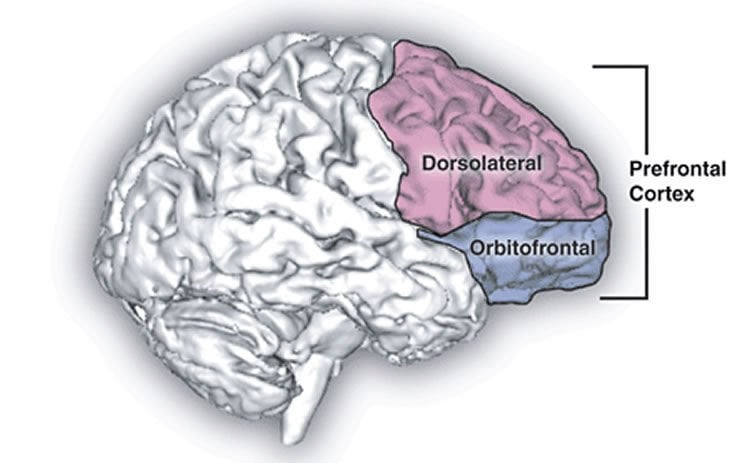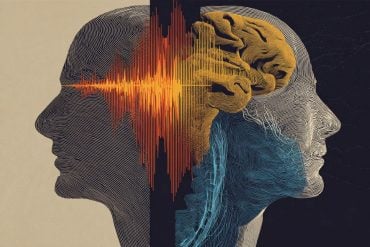Summary: Researchers report high density of neurons in the dorsolateral prefrontal cortex play a significant role in resilient dyslexia.
Source: AFTAU.
Dyslexia, a reading disorder, is characterized by a difficulty in “decoding” — navigating between the visual form and sounds of a written language. But a subset of dyslexic people, dubbed “resilient dyslexics,” exhibit remarkably high levels of reading comprehension despite difficulties decoding. What is the precise mechanism that allows certain individuals with dyslexia to overcome their low decoding abilities and ultimately extract meaning from text?
A new joint Tel Aviv University and University of California San Francisco study identifies the brain mechanism that accounts for the discrepancy between low decoding skills and high reading comprehension.
The research was led jointly by Dr. Smadar Patael of TAU’s Department of Communication Disorders and Prof. Fumiko Hoeft, who is currently at the University of California San Francisco and starts as director of the University of Connecticut’s Brain Imaging Research Center this fall. The research was recently published in PLOS One.
Measuring gray matter
The research points to a larger volume of gray matter in resilient readers in the part of the brain responsible for executive functions and working memory. This specific region, the dorsolateral prefrontal cortex (DLPFC) of the left hemisphere, is known as the “air traffic controller” or “conductor” of the brain. Gray matter is the darker tissue of the brain and spinal cord, consisting mainly of nerve cell bodies and branching dendrites.
Researchers examined 55 English-speaking children aged 10-16 with a wide range of reading abilities. Half of these children had been diagnosed with dyslexia. The researchers created a simple formula to calculate the difference between the reading abilities and decoding skills of the participants. The participants were scanned with an MRI. The researchers then compared the mapped images of the participants’ brains with their reading skill results.

“We wanted to find whether the brain regions related to language or other regions were responsible,” says Dr. Patael. “We found that the region in the left frontal part of the brain known as left DLPFC was directly related to this discrepancy. DLPFC has been shown to be important for executive functions and cognitive controls.”
The chicken or the egg?
“We then sought to understand answer a ‘chicken or egg’ question related to dyslexia and the slight enlargement of this brain region,” Dr. Patael continues. “Do resilient dyslexics have distinct brain structures that allow for better resiliency, or is their success in reading a result of compensation strategies that actually altered the density of neurons in a specific region of the brain?”
To answer this question, Dr. Patael, Prof. Hoeft and their colleagues scanned 43 kindergarteners using MRI technology, and then three years later tested the children’s reading abilities. The researchers found that the density of neurons in the DLPFC predated mature reading ability and predicted the discrepancy, regardless of their initial reading abilities.
“This helps us to understand the brain and cognitive mechanisms these children utilize to enable them to do well despite their relative weakness in decoding. It may help us think about incorporating relatively new strategies into reading interventions,” says Prof. Hoeft.
“Much of the curriculum of kindergarten reading readiness is focused on learning sounds of letter and phonological awareness,” concludes Dr. Patael. “Our research findings suggest new approaches that emphasize executive functions and working memory. If your child is entering first grade, practicing the alphabet may not be enough. Consider activities that require working memory, such as baking cakes and playing song and strategy games. These activities stimulate children’s working memory and may in time foster their ability to comprehend texts well.”
The researchers are currently further exploring the neural mechanisms of compensation and resilience.
Source: George Hunka – AFTAU
Publisher: Organized by NeuroscienceNews.com.
Image Source: NeuroscienceNews.com image is adapted from the AFTAU news release.
Original Research: Open access research for “Brain basis of cognitive resilience: Prefrontal cortex predicts better reading comprehension in relation to decoding” by Smadar Z. Patael, Emily A. Farris, Jessica M. Black, Roeland Hancock, John D. E. Gabrieli, Laurie E. Cutting, and Fumiko Hoeft in POS ONE. Published July 14 2018.
doi:10.1371/journal.pone.0198791
[cbtabs][cbtab title=”MLA”]AFTAU”Link Found Between Resilience to Dyslexia and Gray Matter in Frontal Cortex.” NeuroscienceNews. NeuroscienceNews, 26 July 2018.
<https://neurosciencenews.com/gray-matter-dyslexia-9620/>.[/cbtab][cbtab title=”APA”]AFTAU(2018, July 26). Link Found Between Resilience to Dyslexia and Gray Matter in Frontal Cortex. NeuroscienceNews. Retrieved July 26, 2018 from https://neurosciencenews.com/gray-matter-dyslexia-9620/[/cbtab][cbtab title=”Chicago”]AFTAU”Link Found Between Resilience to Dyslexia and Gray Matter in Frontal Cortex.” https://neurosciencenews.com/gray-matter-dyslexia-9620/ (accessed July 26, 2018).[/cbtab][/cbtabs]
Abstract
Brain basis of cognitive resilience: Prefrontal cortex predicts better reading comprehension in relation to decoding
Objective
The ultimate goal of reading is to understand written text. To accomplish this, children must first master decoding, the ability to translate printed words into sounds. Although decoding and reading comprehension are highly interdependent, some children struggle to decode but comprehend well, whereas others with good decoding skills fail to comprehend. The neural basis underlying individual differences in this discrepancy between decoding and comprehension abilities is virtually unknown.
Methods
We investigated the neural basis underlying reading discrepancy, defined as the difference between reading comprehension and decoding skills, in a three-part study: 1) The neuroanatomical basis of reading discrepancy in a cross-sectional sample of school-age children with a wide range of reading abilities (Experiment-1; n = 55); 2) Whether a discrepancy-related neural signature is present in beginning readers and predictive of future discrepancy (Experiment-2; n = 43); and 3) Whether discrepancy-related regions are part of a domain-general or a language specialized network, utilizing the 1000 Functional Connectome data and large-scale reverse inference from Neurosynth.org (Experiment-3).
Results
Results converged onto the left dorsolateral prefrontal cortex (DLPFC), as related to having discrepantly higher reading comprehension relative to decoding ability. Increased gray matter volume (GMV) was associated with greater discrepancy (Experiment-1). Region-of-interest (ROI) analyses based on the left DLPFC cluster identified in Experiment-1 revealed that regional GMV within this ROI in beginning readers predicted discrepancy three years later (Experiment-2). This region was associated with the fronto-parietal network that is considered fundamental for working memory and cognitive control (Experiment-3).
Interpretation
Processes related to the prefrontal cortex might be linked to reading discrepancy. The findings may be important for understanding cognitive resilience, which we operationalize as those individuals with greater higher-order reading skills such as reading comprehension compared to lower-order reading skills such as decoding skills. Our study provides insights into reading development, existing theories of reading, and cognitive processes that are potentially significant to a wide range of reading disorders.






